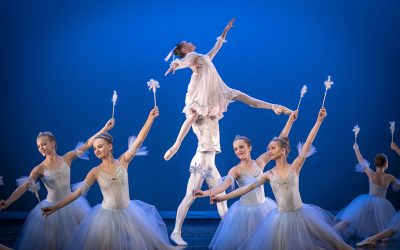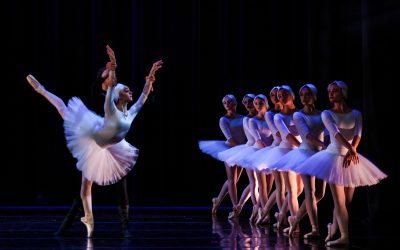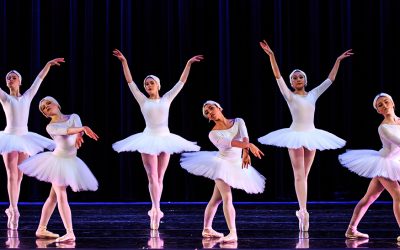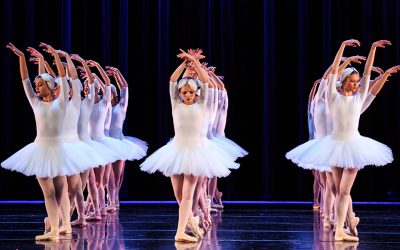Engaging your child in extracurricular activities (those “outside of school” activities) is an instinct that comes naturally to most parents. We want to support our children’s development while giving them beneficial outlets for their time and energy.
For many parents and students, the extracurricular activity of choice is dance.
What Does Dance Do for a Child?
While dance can impact each child differently, some outcomes seem universal. Below are some of the top positive benefits dance offers children.
Boosts Confidence
One of the things dance does for a child is increases their confidence. This is true for many extracurricular activities—practice in certain skills brings confidence. However, for dance, it’s even more than that.
Even when you’re dancing someone else’s choreography, dance is personal. It gives you an outlet to bring yourself into the room or onto the stage and say, “this is me.” Practicing this in a safe setting such as dance helps dancers develop and grow their self-confidence.
Improves Fitness
It goes without saying that dance is a physical sport. However, its type of physicality lends itself well to growing children’s bodies. This is because dance not only provides aerobic activity, but also builds and tones muscles, especially those core muscles that support daily movement.
Teaches Teamwork
Dance probably isn’t one of the first activities that comes to mind when you’re thinking of team sports, but dance truly does require this skill.
As part of a dance class or company, children have to rely on the other dancers on stage with them. Each dancer has to be in the right spot and doing the right moves to support the choreography as a whole. For the routine to look synchronized, dancers also have to be at relatively similar levels of expertise.
Dance teaches teamwork because it requires dancers to work together on stage during performances, in rehearsals for staging and practicing choreography, and in developing and mastering techniques alongside their peers.
Encourages Grit
Next on the list of things dance does for a child is encouraging grit. Dance is a commitment—one that extends at least to a several-month-long season and at most to a long-term company relationship. As with every activity, your child will experience times when they want to give up or quit and have to find ways to stay motivated to keep dancing. According to development experts, this skill, called “grit,” is one of the most important indicators of success in children.
If your child is struggling with staying committed to dance, read this recent article on How to Keep Your Child Motivated to Stick With Dance.
Provides Outlet for Expression
Many dancers in their early to late teens face the changes of adolescence that bring a pendulum of emotions. It’s important for them to have an outlet where they feel safe expressing these emotions and helping them to explore and release them instead of bottling them up. For many, dance is an excellent outlet for this.
Drives Discipline
Finally, dance helps children develop discipline. Like many extracurricular activities, dance requires the mastery of certain techniques. This means your child is required to practice certain techniques until they can perform them correctly. This skill means your child will be practicing the skill of discipline.
What has dance done for you or your child?
Did dance help you make friends? Improve other sports skills? Let us know below what dance did for you!
About the Author

Jennie Creer-King
Owner & Artistic Director
Jennie Creer-King is the owner and artistic director of Central Utah Ballet Academy. She is an award-winning dancer, instructor, and choreographer. Among her awards include “Best School Award” by the Youth American Grand Prix, “Best of State” in Choreography and Youth Performing Group, and the Presidential Scholar’s Teacher Recognition Award. Jennie has a Bachelor's Degree from the University of Utah School of Dance with an emphasis in Ballet Performance and a Master's Degree from the University of Utah School of Dance emphasis in teaching pedagogy and choreography.
You may also be interested in...
What It Takes to be a Ballet Dancer
Though professional ballerinas make the dance look effortless, there is a great deal of physical and psychological stamina behind the glamour of ballet. Not to mention the countless hours of practice to perfect form and match the gracefulness of top talent. Lastly, we...
Can You Start Ballet at 13 Years old?
As most ballerinas start their journeys young, we often get asked the question of how late is “too late” to start ballet. Our bottom line is that it is never too late to start dancing ballet. Many people start learning as adults! Though it is more difficult to dance...
Tips for Getting Better at Ballet
Do you feel you’ve plateaued in your ballet career? Or are you simply just not improving as quickly as you’d hoped? It’s important not to skip ahead to skills we’re not flexible or strong enough for. Instead, follow these proven tips to elevate your ballet career. 4...
Can You Teach Yourself Ballet?
If you are interested in learning ballet but aren’t sure you can put the time or financial investment toward classes, you may be wondering if you can teach yourself ballet. Ballet is a beautiful, fulfilling form of dance. It encompasses strength, flowing lines,...
25 Must-Know Ballet Terms
Some students are intimidated by ballet because instructors sometimes seem like they’re speaking a foreign language--because that’s just what it is! Ballet terms are French, and classical ballet instructors will use this terminology to create structure and help...
Central Utah Ballet Artistic Director, Jennie Creer-King, Unveils New Professional Ballet Company, Chrysalis Ballet
Jennie Creer-King, owner and director of Central Utah Ballet in Lehi, Utah, announces brand new professional ballet company Chrysalis Ballet with Associate Director, Garret Smith FOR IMMEDIATE RELEASE LEHI, UTAH, April 2021---Jennie Creer-King, owner and artistic...
Learn to Appreciate Ballet: 7 Steps
For those who weren’t raised in the ballet community, watching a ballet can seem foreign—and maybe even boring. Ballet is a nuanced art that can make it more difficult to appreciate for some casual observers. However, with the right approach and mindset, anyone can...
How to Make the Most of Summer Ballet Intensives
If you’re like most ballet dancers, summer means one thing: summer intensives. Summer intensives are an age-old tradition where dancers get together for several weeks of rigorous training and exceptional practice during the summer months when other distractions like...
Central Utah Ballet Announces Their Summer Programs for 2021
Central Utah Ballet, a new ballet school in Lehi, Utah, with owner and artistic director Jennie Creer-King, has announced summer intensive programs and camps to help aspiring dancers further their classical ballet skills and training. FOR IMMEDIATE RELEASE LEHI, UTAH,...









Looking forward to reading more. Great blog article! Shauna Otes Britta
How do I subscribe to your blog? Thanks for your help.